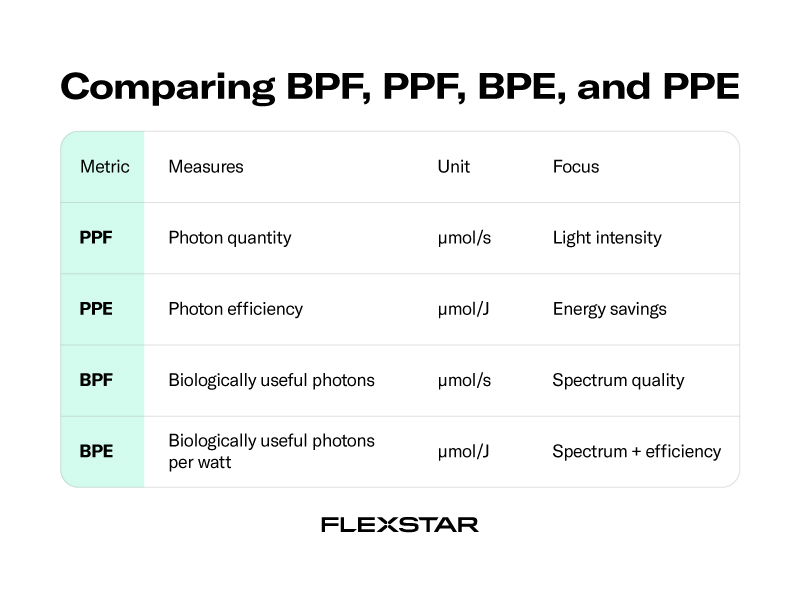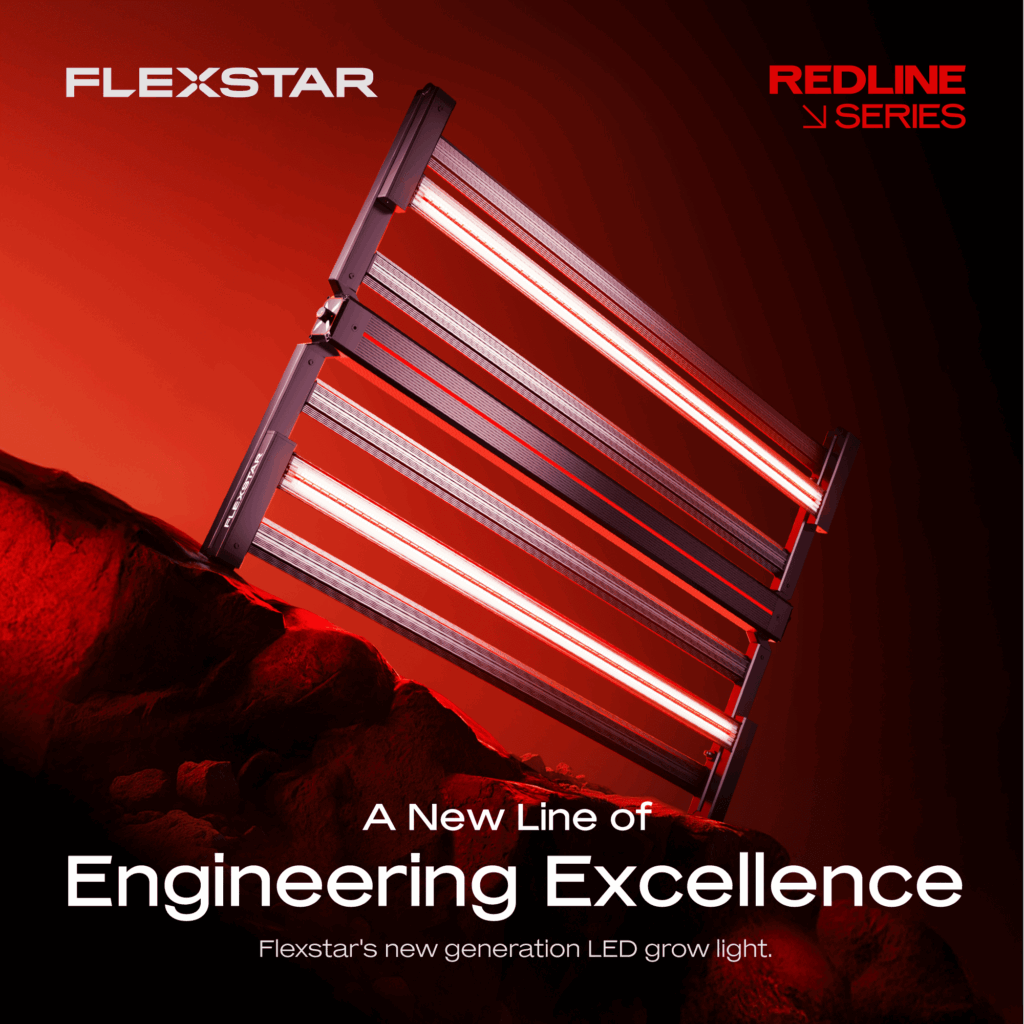Lighting in cultivation is more than just flipping a switch. It’s the engine of plant life indoors—and understanding how that light works is your edge as a grower. Whether you’re growing leafy greens or terpene-rich cannabis, metrics like PPF, PPE, BPF, and BPE are game-changers in dialing in yield, quality, and efficiency.
Let’s break down these terms in a way that actually makes sense—and show you how to use them to grow better.
1. Introduction to Grow Light Metrics
Why Light Quality and Efficiency Matter in Cultivation
Lighting is one of the most powerful tools a grower has. It drives photosynthesis, affects morphology, and controls the entire plant lifecycle. But intensity alone doesn’t cut it. You need the right spectrum, the right quantity, and the right efficiency—that’s where these four key metrics come in.
The Rise of Advanced LED Grow Lighting
LEDs have taken over the cultivation space for good reason: they’re efficient, durable, and tunable. And they’ve brought a new wave of technical data—PPF, PPE, BPF, BPE—that helps growers customize their grow like never before.
2. What is PPF (Photosynthetic Photon Flux)?
Definition and Units (μmol/s)
PPF measures how many photons are emitted by a light source per second in the PAR range (400–700 nm). It’s measured in micromoles per second (μmol/s). Think of it as the quantity of usable light.
How PPF Affects Plant Growth
More photons = more photosynthesis. But PPF doesn’t measure how well those photons are absorbed or used by the plant—just that they exist.
Common Misconceptions About PPF
Higher PPF doesn’t always mean better. If the spectrum is off, or the distribution is poor, you might be blasting photons that your plants can’t use efficiently.
3. What is PPE (Photosynthetic Photon Efficacy)?
Definition and Calculation (μmol/J)
PPE shows how efficiently a light converts electrical energy into usable light. It’s the ratio of PPF to the power consumed (watts), measured in micromoles per joule (μmol/J).
Why PPE Is Key for Energy Efficiency
Growers chasing lower power bills and rebate eligibility should look for lights with high PPE—generally 2.6 μmol/J or higher.
PPE vs PPF—What’s the Difference?
PPF = total photons.
PPE = photons per watt.
You can have a light with high PPF but terrible PPE if it’s guzzling energy.
4. What is BPF (Biological Photon Flux)?
Moving Beyond PAR – Considering UV and Far-Red
BPF includes wavelengths outside the traditional PAR range, like UV-A and Far-Red, which have biological impact on plant growth, development, and quality.
How BPF Reflects Real Plant Impact
Unlike PPF, BPF considers whether the emitted photons are actually triggering biological responses like resin production, branching, or stretching.
Importance of Spectral Distribution in BPF
A light can have identical PPF and vastly different BPF depending on how it spreads its spectrum. This makes spectrum design just as important as total output.
5. What is BPE (Biological Photon Efficacy)?
The New Frontier in Measuring Light Effectiveness
BPE combines the efficiency of PPE with the quality of BPF. It shows how well a light uses electricity to produce biologically relevant photons.
BPE as the Bridge Between Spectrum and Efficiency
BPE fills the gap. It tells you not only how much light you’re getting or how efficiently, but how useful that light is to the plant.
Why BPE is Crucial for Craft and Commercial Growers
For boutique cultivators chasing terpenes and bag appeal, or commercial ops maximizing grams per watt—BPE is the metric that really matters.

6. When to Prioritize Each Metric
Energy cost-sensitive? Focus on PPE.
Targeting yield + quality? Aim for high BPE and BPF.
Need pure output? Check PPF, but make sure spectrum matches your crop.
7. How to Choose the Right Light Based on These Metrics
Questions Growers Should Ask
What’s the PPF and PPE?
Does the light emit UV and Far Red?
Can I control the spectrum?
What’s the expected lifespan?
Tips for Evaluating Spec Sheets and Marketing Claims
Don’t fall for just high numbers. Ask for third-party testing. Look for full spectrum coverage, high BPE, and durability guarantees.
8. Why Redline Series Excels Across All Metrics
At Flexstar, we’re committed to providing growers with the tools and knowledge they need to succeed. Our newest Redline series embodies this commitment, delivering exceptional PPF and PPE, along with carefully considered BPF and BPE for optimal plant growth and efficiency.
Tunable Spectrum and High BPE
Redline gives you total control over your light recipe, allowing you to dial in growth phase–specific spectrum for higher up to 3480 μmol/S of BPF and 3.1 μmol/J of BPE.
Energy Efficiency with High PPE (3.2 μmol/J)
With PPE ratings above industry standards, Redline delivers serious photons without driving up your power bill.
The next evolution of cultivation starts with the right light. Make sure yours speaks the right language.
Conclusion
Understanding BPF, PPF, BPE, and PPE isn’t just about chasing better lighting—it’s about growing smarter. These metrics help you cut costs, boost yields, and refine quality. Don’t just settle for any light. Look at the numbers that matter, and choose a fixture that gives you control, efficiency, and lasting results.
FAQs
1. What is the difference between PPE and BPE?
PPE measures efficiency of all PAR photons, while BPE focuses on biologically active photons—giving a more accurate picture of plant impact.
2. Is BPF better than PPF?
Not better—just different. PPF is about quantity, BPF is about quality and spectrum relevance.
3. Do energy rebates consider PPE or BPE?
Most rebates are based on PPE. However, BPE is growing in importance for long-term performance value.
4. Can spectrum tuning really improve yield?
Absolutely. Adjusting spectrum lets you influence stretch, resin, and even terpene profiles.

